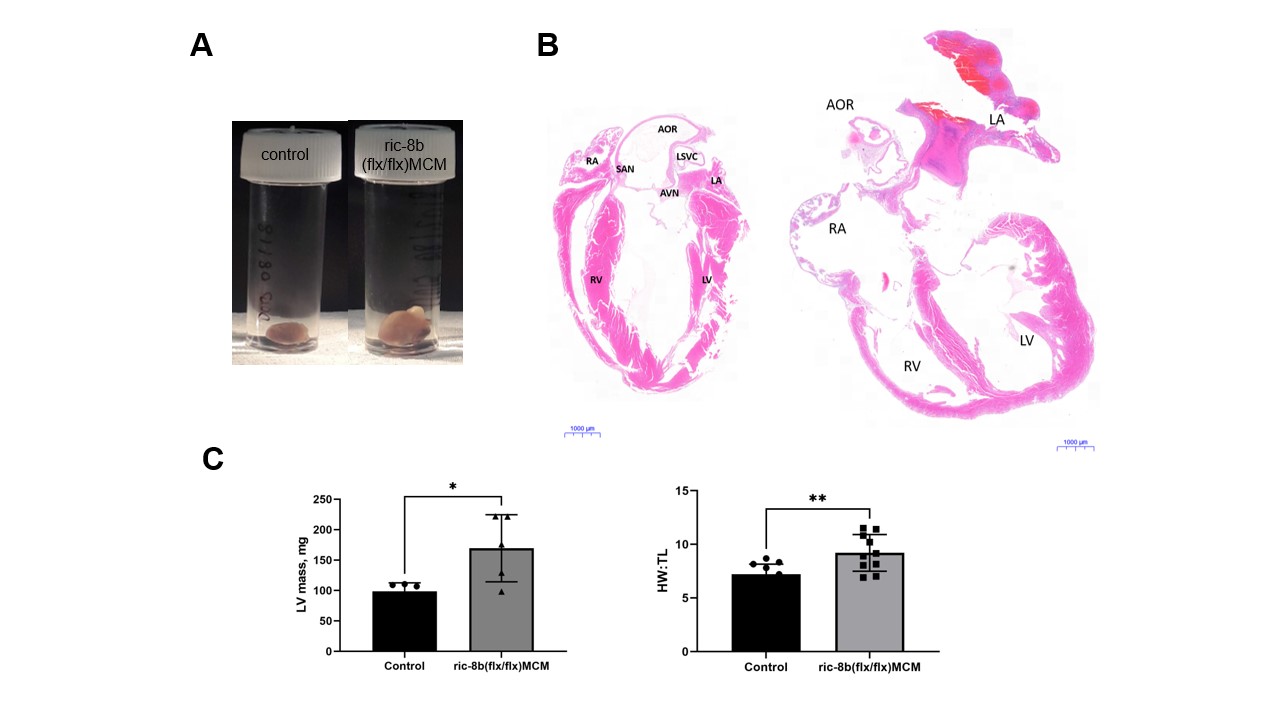Resistance to inhibitors of cholinesterase are involved in modulating G-protein function but little is known of their potential physiological importance in the heart. In the present study, we have assessed the role of resistance to inhibitors of cholinesterase 8b (Ric-8b) in determining cardiac contractile function. We developed a novel murine model in which it was possible to conditionally delete ric-8b in cardiac tissue in the adult animal after the addition of tamoxifen. Deletion of ric-8b led to severely reduced contractility as measured using echocardiography days after administration of tamoxifen. Histological analysis of the ventricular tissue showed highly variable myocyte size, prominent fibrosis and an increase in cellular apoptosis. At the cellular level, the deletion of ric-8b led to loss of activation of the L-type calcium channel through the β-adrenergic pathways. Using fluorescence resonance energy transfer based assays in heterologous expression systems we showed ric-8B protein selectively interacts with the stimulatory G-protein, Gαs. We then explored if deletion of gnas (the gene encoding Gαs) in cardiac tissue using a similar approach in the mouse led to an equivalent phenotype. The conditional deletion of the Gαs gene in the ventricle led to comparable effects on contractile function and cardiac histology. We conclude that ric-8b is essential to preserve cardiac contractile function likely through an interaction with the stimulatory G-protein. All mice were kept in a pathogen-free temperature-controlled environment (21-23°C) with 12-hour day/12-hour night light cycles. Animal were allowed access to standard rodent chow and water add-libitum. Mice were studied between 10-12 weeks of age. Use of animals in all the studies was in accordance with the United Kingdom Animal (Scientific Procedures) Act of 1986 and procedures were undertaken under PPL 707665 and PE9055EAD. Mice were killed by terminal anaesthesia.
Novel Mechanisms of Disease and Arrhythmias (University of Liverpool, UK) (2023) Proc Physiol Soc 53, C29
Poster Communications: Resistance to inhibitors of cholinesterase 8b (Ric-8b) are key to preserving contractile function in the murine adult heart.
Elena Tsisanova1, Muriel Nobles1, Sonia Sebastian1, Keat-Eng Ng1, Alison Thomas1, Patricia Munroe1, Andrew Tinker1,
1Department of Clinical Pharmacology and Precision Medicine, William Harvey Research Institute, Barts and The London School of Medicine and Dentistry, Queen Mary University of London London United Kingdom, 2Department of Clinical Pharmacology and Precision Medicine, William Harvey Research Institute, Barts and The London School of Medicine and Dentistry, Queen Mary University of London London United Kingdom, 3Department of Clinical Pharmacology and Precision Medicine, William Harvey Research Institute, Barts and The London School of Medicine and Dentistry, Queen Mary University of London London United Kingdom, 4Department of Clinical Pharmacology and Precision Medicine, William Harvey Research Institute, Barts and The London School of Medicine and Dentistry, Queen Mary University of London London United Kingdom, 5Department of Clinical Pharmacology and Precision Medicine, William Harvey Research Institute, Barts and The London School of Medicine and Dentistry, Queen Mary University of London London United Kingdom, 6Department of Clinical Pharmacology and Precision Medicine, William Harvey Research Institute, Barts and The London School of Medicine and Dentistry, Queen Mary University of London London United Kingdom,
View other abstracts by:
Where applicable, experiments conform with Society ethical requirements.


